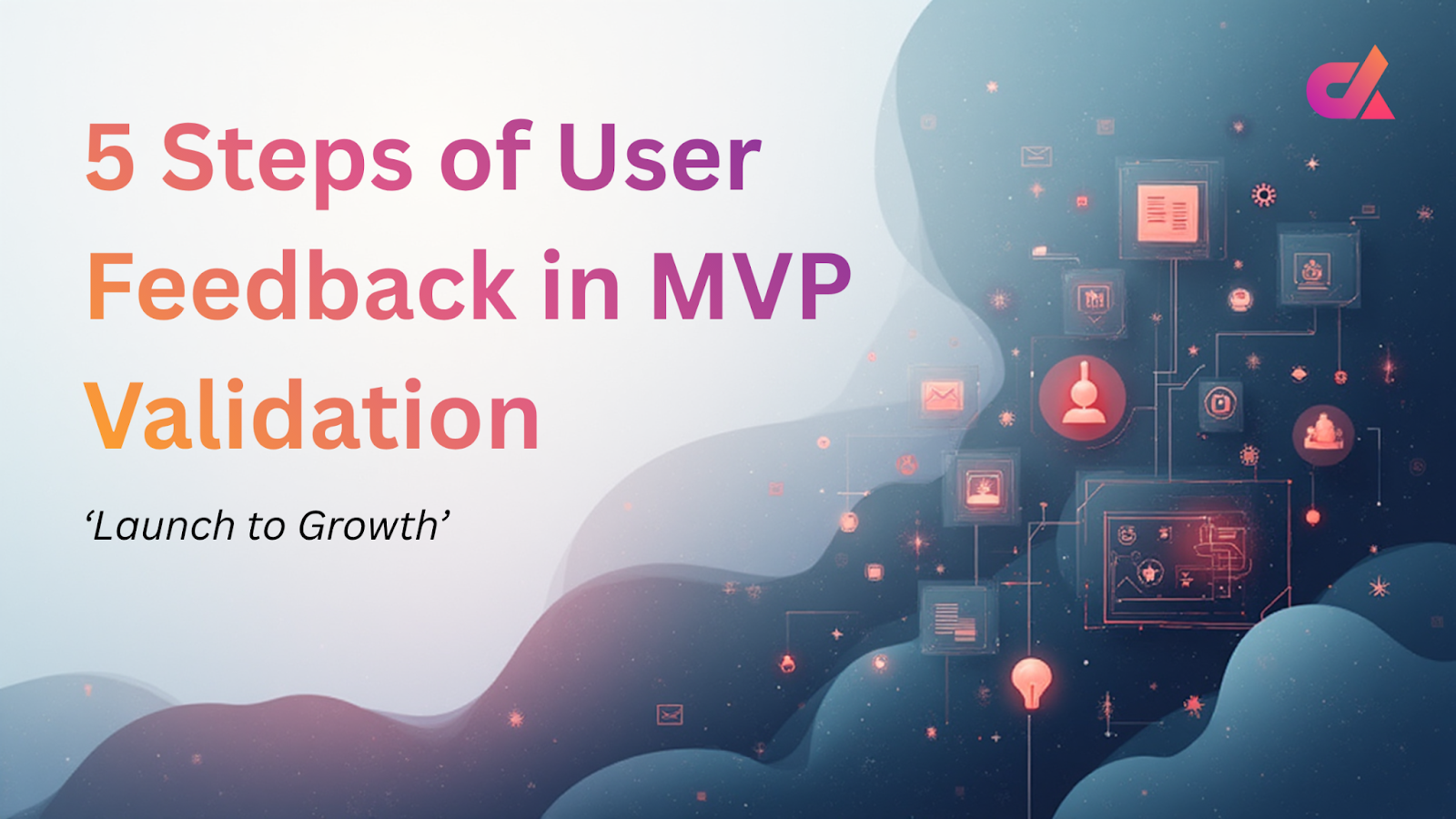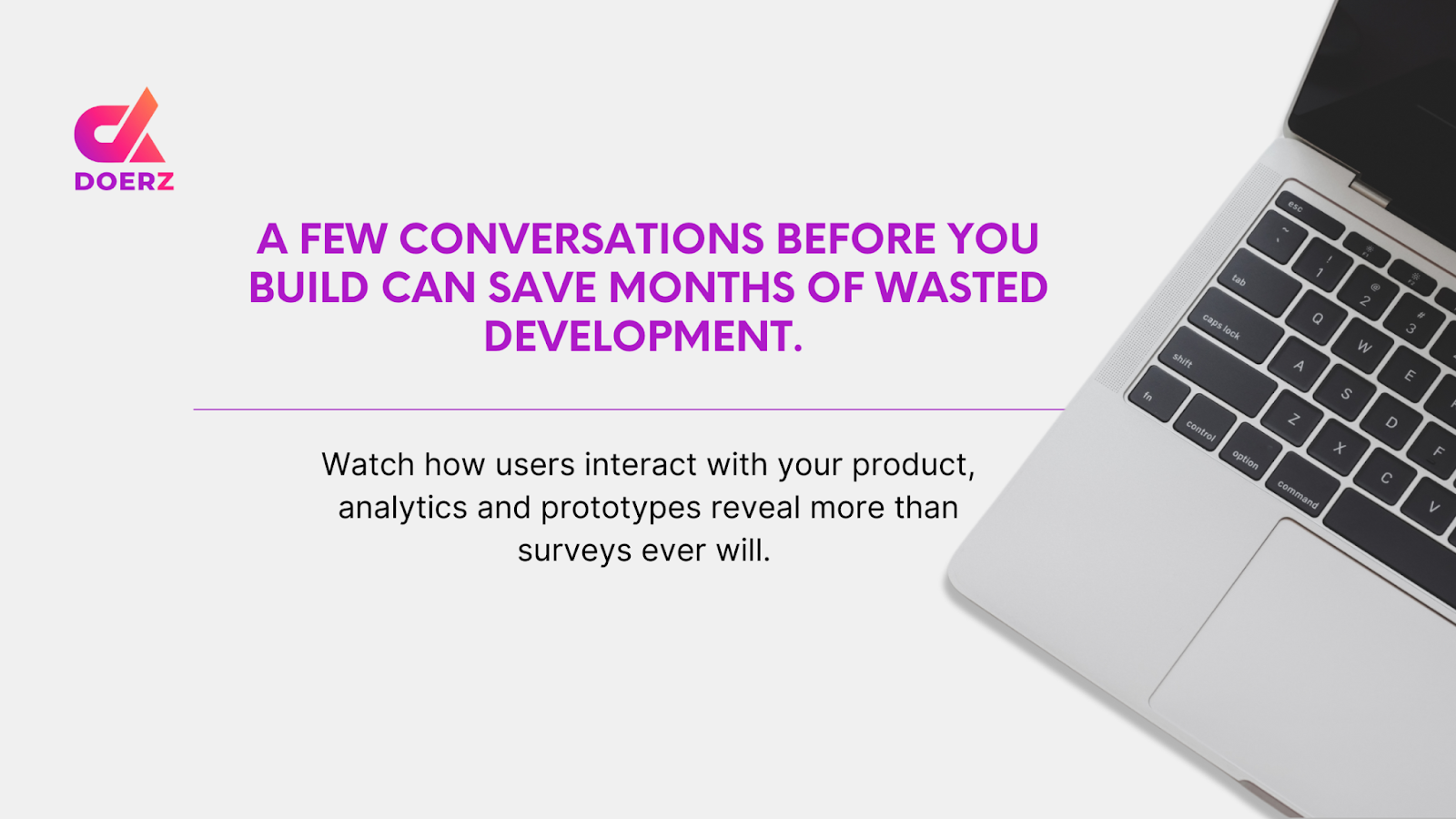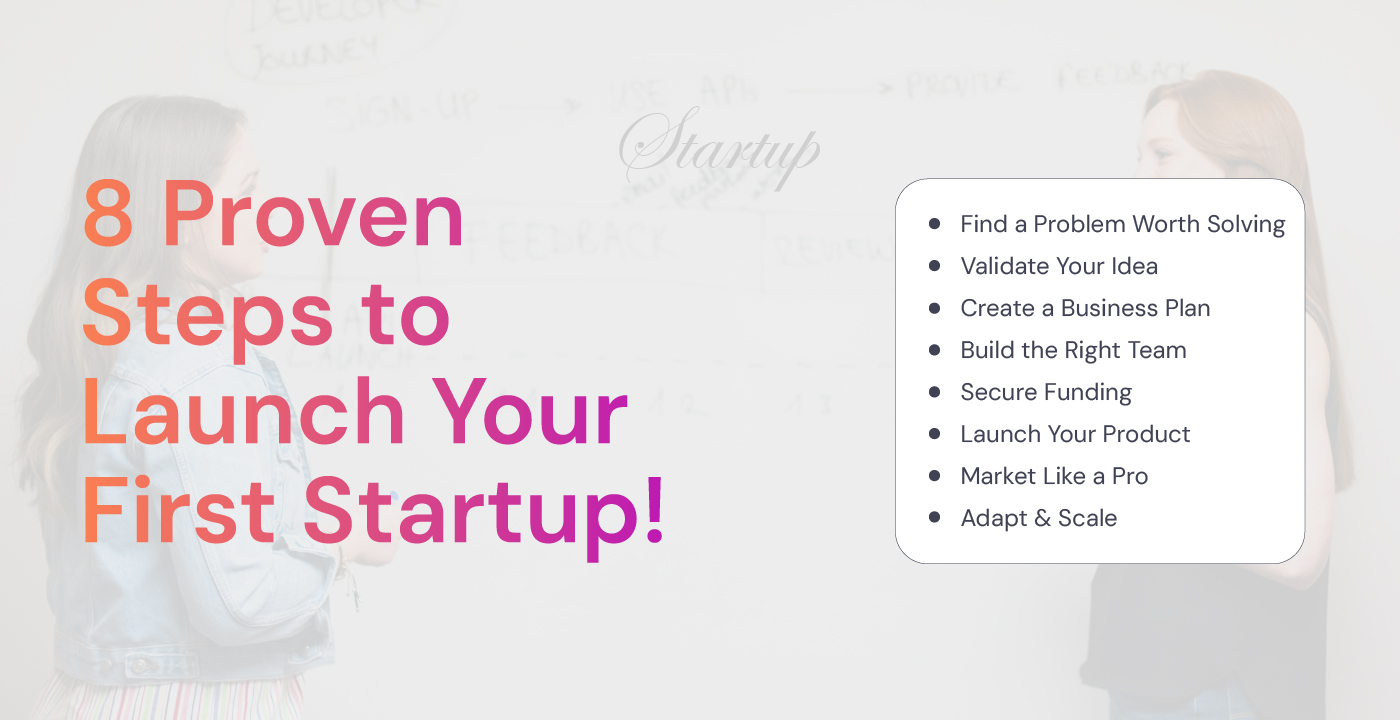You have built your MVP, a small, working slice of your vision. You are excited, anxious, maybe a little terrified and you send the link to your first few users and wait.
And then… nothing.
A couple of clicks. Some signups. One polite “Looks cool!” from your friend. But no wave of enthusiasm. That silence is the moment that decides if your startup grows or dies. Because the #1 thing you need is user feedback in MVP.
Building the MVP is only half the story. The real growth, the proof that your idea matters, begins when users start talking.
Welcome to the world of feedback loops, the main core of MVP validation.
Feedback: The MVP’s Primary Data Input?
Here’s the startup truth few people talk about: an MVP without feedback is just a lucky guess.
The whole point of the Minimum Viable Product is to learn, not to launch perfectly. It is not about proving you are right. It’s about discovering what’s right.
Reid Hoffman, the founder of LinkedIn, said, “If you are not embarrassed by the first version of your product, you have launched too late.”
What makes a product viable isn’t its design or code (they do, but all in good time), the first thing is whether users confirm its value.
That’s why even a small MVP built with focused feature selection can reveal if your idea truly resonates with users.
5 Steps in Continuous “User Feedback in MVP” Loop
User feedback in MVP is a conversation that never ends.
It begins long before you launch and continues long after version 1.0.
There are five essential stages in that conversation, five ways your users quietly (and loudly) tell you what matters.
1. The Pre-MVP Stage: Listening Before You Build
Before you start designing screens, you need to answer one brutally honest question:
“Is this problem real enough that people want it solved?”
Problem validation happens here, and it’s where too many founders skip ahead. Don’t. Because the best MVPs start with deep empathy.
Spend a few days talking to potential users. Not a marketing survey, a human conversation. Ask:
- What’s the hardest part about [the problem] right now?
- How are you currently solving it?
- What’s the one thing you wish existed?
When you hear emotional words like “hate,” “waste,” or “every week it drives me crazy,” that’s your sign. That’s a pain.
Even a simple landing page explaining your solution with a “Join Waitlist” button can show early interest, just like pre-launch planning impacts pre-seed development budgeting.
2. Prototype Feedback: Testing the Flow Before the Code
Once you have validated the problem, it’s time to test how users might solve it, without writing a single line of code.
Using tools like Bolt, you can build a clickable mockup that feels real enough to test. This stage is all about observing how people interact.
Sit beside them (or over Zoom) and watch silently as they navigate. Don’t explain. Don’t guide. Just observe where they hesitate, where they click, and where they get lost.
Ask them:
- “What do you think this screen does?”
- “Where would you click first?”
- “Was there a moment you felt confused?”
Pro Tip → Record your screen (with permission).
You will catch subtle moments of confusion or delight that feedback forms never capture.
This stage reveals usability friction, the small design flaws that could derail your MVP later.
Even a small prototype can help you test ideas before committing to future-ready app architecture to make sure your app scales efficiently.
3. MVP Launch: Listening to What Users Do (Not Just What They Say)
Now your MVP is live. You have real users, real data and real stakes.
This is the moment that separates assumptions from evidence.
People’s comments and their real behavior can be different. You need both qualitative and quantitative feedback.
Track Behavior, Not Only Opinions!
- Analytics tools (like Google Analytics or Mixpanel) show what users actually do.
- Session replay tools (like Hotjar or FullStory) reveal drop-offs and clicks.
- Surveys and support tickets show what frustrates them most.
Look for patterns.
Where do users stop?
What’s ignored?
Which feature do they use most?
Your job during MVP launch isn’t to defend your product. It’s to watch it teach you.
4. Iteration Feedback: Refining, Removing, and Repeating
Once data starts flowing, you’ll be tempted to fix everything at once. Don’t.
Feedback without prioritization is chaos.
Structured frameworks like the ICE Method (Impact, Confidence, Ease) works here. For each idea, ask:

Start with the highest combined score, small wins that deliver noticeable improvements fast.
Also, distinguish between core feedback (affecting your value proposition) and cosmetic feedback (preferences that don’t move the needle).
A founder’s worst mistake is saying yes to everything. A good founder listens carefully but executes selectively.
5. Scaling Feedback: Turning Users into Co-Creators
After a few cycles of testing and iterating, your MVP starts feeling solid. You have traction, retention, and recurring feedback themes.
This is when you move from validation to evolution.
Now, your feedback strategy should grow with your user base:
Add Systematic Feedback Channels!
- In-app prompts: A single “How was your experience?” after key actions.
- Net Promoter Score (NPS): Measure how likely users are to recommend you.
- Community groups: Create a Slack or Discord space for power users.
- Customer interviews: Monthly check-ins with your most active customers.
This turns feedback into a culture, not a task. You stop collecting feedback about your product and start co-creating it with your users.
Structured channels like these turn feedback into co-creation, just as companies like Figma and Notion grew by integrating user input directly into development. Even a solid MVP built on scalable app architecture benefits more from this stage.
How Does User Feedback Shape MVP Success?
Every feedback loop answers a different validation question:
| Stage | Feedback Type | Validation Goal |
| Pre-MVP | Interviews, surveys | Confirms problem exists |
| Prototype | Usability tests | Validates product clarity |
| Launch | Analytics + qualitative input | Measures feature desirability |
| Iteration | Prioritized improvements | Increases retention |
| Scaling | NPS, communities | Confirms long-term value |
Avoid 5 User Feedback in MVP Pitfalls
(They Kill MVPs Fast)
Even well-intentioned founders trip here. Watch for these classic mistakes:
1. Confirmation Bias: Hearing Only What You Want to Hear
This is the founder’s blind spot. You hear praise and ignore the friction. It’s easy to filter feedback that supports your original idea but that’s not learning, that’s validation theater.
Real growth begins when you listen to uncomfortable truths. Seek out the critics, the confused users, and the ones who walked away. They’re telling you what needs fixing, not what you want to hear.
2. Overbuilding: Solving Everything at Once
When users start sharing ideas, it’s tempting to build them all. You add dashboards, filters, and animations, and suddenly your MVP isn’t “minimum” anymore.
The danger is that you end up testing too many variables at once, making it impossible to know what actually drives engagement.
Stay disciplined. Prioritize features that solve one validated pain point first. Simplicity is your superpower in the MVP stage.
3. Ignoring Silent Users: The Quiet Ones Are Speaking Too
Not every user complains, some just disappear. And those silent exits can teach you the most.
Churned users often reveal hidden usability issues or unmet expectations. Moreover, follow up with short exit surveys, check analytics for drop-off points, and treat silence as a signal, not a shrug.
4. Poor Documentation: Letting Feedback Get Lost
You gather insights in emails, DMs, spreadsheets, and sticky notes. Then, two weeks later, you can’t find half of them. Sound familiar?
Unorganized feedback kills iteration. Create a simple, central system, a Notion board, an Airtable sheet, or a Trello tracker to log every piece of user input. Tag by issue type, frequency, and priority.
Patterns will emerge faster, and decisions will become data-driven, not memory-based.
5. No Iteration: Listening Without Acting
The worst feedback mistake isn’t ignoring users; it’s nodding, taking notes, and never changing anything.
If feedback doesn’t drive updates, your MVP becomes static. The fastest-growing products run tight feedback-action loops, test, learn, fix, repeat.
Even small improvements (a simpler signup, a clearer CTA) show users that their voices matter and that builds trust as much as product value.
Building a Continuous User Feedback in MVP Culture
True MVP validation isn’t an event. It’s a mindset.
Make feedback a ritual:
- Weekly: Talk to at least 2–3 real users.
- Monthly: Review analytics and usage patterns.
- Quarterly: Run usability audits for fresh eyes.
You will start seeing a pattern: the better you listen, the faster your intuition sharpens. Every complaint becomes an opportunity. Every bug uncovers a blind spot.
When you treat feedback as fuel, not failure, your product grows organically around what users actually need, not what you imagined they would.
Conclusion
The best founders aren’t the ones who guess right; they are the ones who learn fast.
Of course, understanding which feedback to act on and turning it into real improvements isn’t easy. That’s why many teams work with partners who specialize in building MVPs and structured feedback loops, like the team at Doerz Tech, to help make sense of user insights and turn them into meaningful product growth.
So don’t fear the feedback. Chase it. Embed it. Live by it.
Because every startup you admire today, from Dropbox to Airbnb, wasn’t built by prediction.
It was built by listening.










